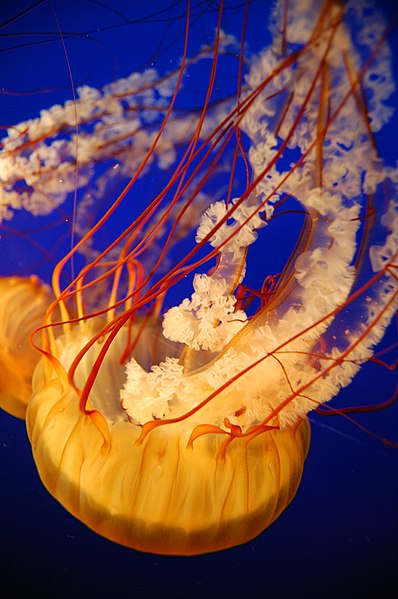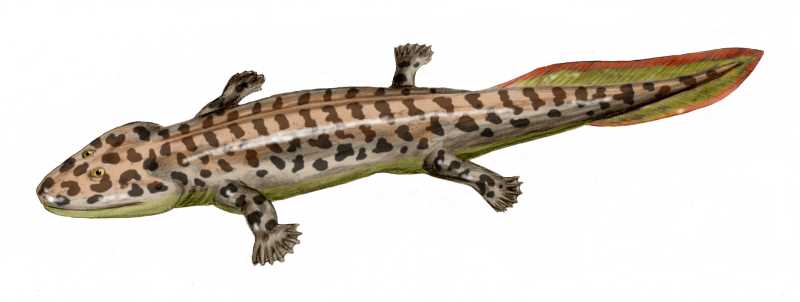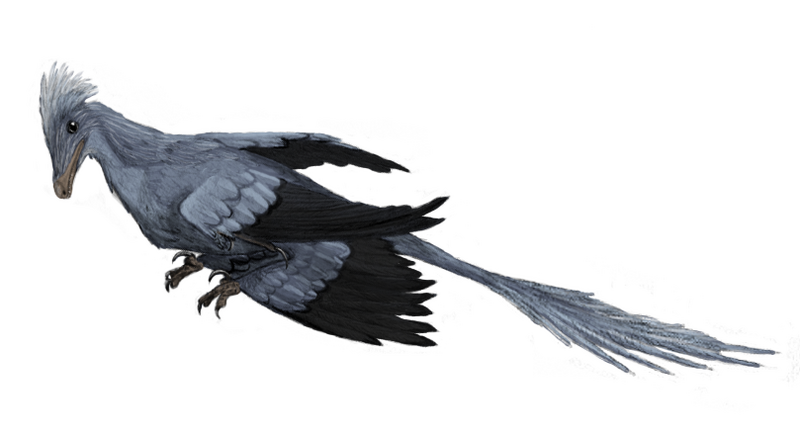Our creation myths start with the assumption that we’re the most important thing in the world, the reason for everything else’s being. The story that science tells relegates us to the periphery. Life has mostly been smaller and simpler than us. I think it’s important to recognize that we might very easily wipe ourselves out, and the microbes will barely have noticed we were even here.
Life appeared very early in the planet’s history, earlier than you might have naively guessed. But then for billions of years, it existed only as simple single cells floating in the ocean or sitting in cracks in the rocks. Big complex creatures visible to the naked eye didn’t appear until the planet was two-thirds of the way to its present age. The first insects didn’t appear until nine-tenths of the way to the present, and humans didn’t show up until ninety-nine percent of the way.
Seeing numbers with nine zeroes in them doesn’t help in imagining the time scales involved here, so I’ll also use the convention that the entire history of the Earth is taking place in one day. In this analogy, one “hour” on the clock is about 192 million years.
midnight (4,600,000,000 years ago)
Earth forms from space dust left over from the new sun.
12:21 am (4,533,000,000 years ago)
Earth collides with the planet Theia, causing rings of debris to form. The rings last for millions of years until they coalesce to form the Moon. (Check out this fun visualization of what the modern Earth would look like with rings.)
2:36 am (4,100,000,000 years ago)
After a lot of volcanic excitement, the surface of the Earth cools enough for the crust to solidify. The atmosphere and oceans form.
3:08 am (4,000,000,000 years ago)
The earliest known life appears. How? In the fifties they thought it was a lightning strike in the primordial soup. Newer theories center around RNA molecules or phospholipids forming little bubbles.
DNA emerges and quickly out-replicates whatever other self-catalyzing chemical reactions are happening. During this time, the atmosphere has no free oxygen.
3:42 am (3,900,000,000 years ago)
Late Heavy Bombardment: the rain of giant rocks from space on the Earth reaches its peak. The oceans boil away completely, more than once, but life persists underground.
5:42 am (3,500,000,000 years ago)
Lifetime of the last known common ancestor of every living thing today. Did it look like this?
8:18 am (3,000,000,000 years ago)
Photosynthesizing bacteria evolve. They release the first free oxygen into the atmosphere, which is a poison for a lot of other bacteria. The moon’s orbit is still very close to the Earth, causing tides a thousand feet high. The planet is continually wracked by hurricane-force winds.
1:01 pm (2,100,000,000 years ago)
More complex cells appear, with various organelles and other internal structures.
These cells probably start out as symbiotic communities of simpler organisms, co-evolving to become inseparable, like modern mitochondria and chloroplasts.
3:44 pm (1,200,000,000 years ago)
Sexual reproduction begins, so child cells no longer need to be exact clones of their parents. The pace of evolution picks up.
4:48 pm (1,000,000,000 years ago)
Simple multicellular organisms appear in the oceans: first colonies of algae, then seaweed.
8:06 pm (600,000,000 years ago)
Cell colonies evolve into sponges, the earliest multicellular animals. Next come jellyfish, with muscles, digestive systems with mouths, and the beginnings of simple neural nets (no brains yet.)
The ozone layer forms, filtering some of the sun’s radiation and allowing the microbes to creep out onto land without getting cooked.
9:12 pm (540,000,000 years ago)
Worm-like creatures get more specialized and complex, with circulatory systems and everything.
9:24 pm (505,000,000 years ago)
The first vertebrates emerge, jawless fish resembling lampreys.
9:30 pm (475,000,000 years ago)
Fish evolve jaws from their frontmost gill arches. They also develop stylish armor plating on their heads and thoraxes. The first plants and fungi move onto land.
9:42 pm (450,000,000 years ago)
The arthropods appear. Since their exoskeletons support and hold water in, they’re the first animals to move onto land, starting with millipedes and centipedes, then spiders and scorpions.
9:54 pm (400,000,000 years ago)
The first insects and sharks appear.
10:06 pm (360,000,000 years ago)
Some lobe-finned fish develop legs, maybe to maneuver through shallow plant-choked swamps. Some of these creatures make short trips onto land.
Plants evolve seeds that protect their embryos, enabling them to spread more quickly on land.
10:24 pm (300,000,000 years ago)
The supercontinent Pangaea forms, eventually providing the name for a great Miles Davis album.
Evolution of the amniotic egg gives rise to reptiles, who can reproduce on land. Insects resembling humungous dragonflies are the first animals to fly. The vast forests of clubmosses, horsetails, and tree ferns will eventually fossilize into coal and oil.
10:42 pm (250,000,000 years ago)
The Permian-Triassic extinction event wipes out about ninety percent of all animal species. Yikes.
10:54 pm (220,000,000 years ago)
Early reptiles diversify into crocodilians, dinosaurs, and pterosaurs. From another reptile branch, the synapsids emerge and evolve into the first tiny ancestors to mammals. (You can see the remnants of our lizard forebears in the scaly tails of rats.)
Conifers become the dominant land plants. Plant-eating animals get bigger to house the long digestive tracts it takes to digest the not-very-nutritious pine trees.
11:00 pm (200,000,000 years ago)
Dinosaurs survive a mass extinction and grow enormous. Modern amphibians emerge, including frogs and salamanders.
11:04 pm (180,000,000 years ago)
Pangaea begins to break up into big land masses. The biggest is Gondwana, made up of Antarctica, Australia, South America, Africa, and India. Antarctica is covered with lush forests. North America and Eurasia are still joined. The first true mammals appear.
11:13 pm (150,000,000 years ago)
Giant dinosaurs dominate the land, the ones we all learned about in second grade. The earliest birds evolve from therapod dinosaurs.
11:18 pm (135,000,000 years ago)
Microraptor gui, a two foot long dinosaur in Northeast China, has bird-like feathered wings on four limbs.
11:19 pm (130,000,000 years ago)
Plants evolve flowers, setting off a major burst of animal co-evolution, like bees.
11:21 pm (125,000,000 years ago)
Ancestors of placental mammals that look like mice live in small shrubs in China.
11:37 pm (75,000,000 years ago)
Lifetime of the last common ancestor of humans and mice. Birds with teeth roam the Northern Hemisphere.
11:40 pm (65,000,000 years ago)
The Cretaceous-Tertiary extinction event wipes out about half of all animal species, including all non-avian dinosaurs. It’s likely caused by a giant asteroid landing off the Yucatan Peninsula.
Without the dinosaurs, mammals can and do get bigger and more diverse. A group of small, tree-dwelling, insect-eating mammals branches out into the ancestors of primates, treeshrews, and bats.
11:44 pm (50,000,000 years ago)
Ancestors of whales walk on land like modern sea lions and swim like modern otters. Ancestors of manatees walk like hippos and also swim like otters. The ancestors of dogs, cats, bears and raccoons are meat-eating, weasel-like tree climbers.
11:47 pm (40,000,000 years ago)
Primates diverge into lemurs, tarsiers, monkeys and apes.
The earliest elephant is the size of a large pig.
11:49 pm (37,000,000 years ago)
Grasses evolve. The first dogs appear in North America.
11:53 pm (22,000,000 years ago)
India collides with Asia, pushing up the Himalayas. The first bears are the size of foxes and hunt in the tree tops.
11:54 pm (20,000,000 years ago)
The African plate collides with Asia. Gigantic animals roam South America, including eighteen-foot-long giant sloths and flying birds with twenty-foot wingspans.
11:55 pm (16,000,000 years ago)
Whales begin to use echolocation. There are sharks the size of buses.
11:56 pm (13,000,000 years ago)
Human ancestors speciate from orangutan ancestors.
11:57 pm (10,000,000 years ago)
Monkeys proliferate, and the apes go into decline. Human ancestors speciate from gorilla ancestors.
11:58 pm (5,000,000 years ago)
Volcanoes erupt and create Panama. Mammals from North America cross the isthmus and cause extinctions of South American mammals. Human ancestors speciate from chimpanzee ancestors. The largest known primates reach twelve feet tall in Asia.
11:59 pm (3,700,000 years ago)
Australopithecus afarensis leaves footprints on volcanic ash in Kenya.
11:59.04 pm (3,000,000 years ago)
Early hominins live on the savannas of Africa, where they’re hunted by giant cats.
11:59.38 pm (2,000,000 years ago)
Meat-eating Homo species coexist with Paranthropus, hominins who eat plants and termites. Homo habilis uses stone choppers in Tanzania. Broca’s area, the speech region of the modern human brain, begins to emerge.
11:59.40 pm (1,800,000 years ago)
Homo erectus emerges in Africa and migrates to other continents, mostly South Asia.
11:59.46 pm (1,750,000 years ago)
Armadillos the size of cars live in southern Peru.
11:59.76 pm (700,000 years ago)
Common genetic ancestor of humans and Neanderthals.
11:59.82 pm (500,000 years ago)
Homo erectus in China use charcoal to control fire, though they may not yet know how to create it.
11:59.94 pm (195,000 years ago)
The earliest known Homo sapiens live in Ethiopia.
11:59.95 pm (160,000 years ago)
Homo sapiens in Ethiopia practice mortuary rituals and butcher hippos.
11:59.953 pm (150,000 years ago)
“Mitochondrial Eve” lives in Africa, the last female ancestor common to all mitochondrial lineages in humans alive today.
11:59.959 pm (130,000 years ago)
Neanderthals in Europe and the Middle East begin to bury their dead and care for the sick.
11:59.969 pm (100,000 years ago)
Humans live in South Africa and Palestine, probably alongside Neanderthals.
11:59.974 pm (82,500 years ago)
Humans in Zaire fish using spear blades made from sharpened animal bones.
11:59.977 pm (74,000 years ago)
An enormous volcanoic eruption in Indonesia causes the human population to crash as six years without a summer are followed by a thousand-year-long ice age. Volcanic ash up to fifteen feet deep covers India and Pakistan.
11:59.988 pm (40,000 years ago)
Jared Diamond’s “great leap forward.” Humans paint and hunt mammoths in France. Most large mammal species disappear, probably because of the expanding human population.
11:59.990 pm (32,000 years ago)
First known sculpture in Germany. First known flute, made from a bird bone, in France.
11:59.991 pm (30,000 years ago)
Humans enter North America from Siberia, as well as the Solomon Islands and Japan. Bows and arrows are used in the Sahara. Fired ceramic animal models are made in Eastern Europe.
11:59.992 pm (27,000 years ago)
Neanderthals die out, leaving Homo sapiens and Homo floresiensis as the only hominid species. In Eastern Europe, humans invent textiles and press weaving patterns into pieces of clay before firing them.
11:59.994 pm (20,000 years ago)
Oil lamps made from animal fats on shells are used in caves in France. Bone needles are used to sew animal hides in China. Wooly mammoth bones are used to build houses in Russia.
11:59.995 pm (15,000 years ago)
The most recent Ice Age ends. Megafauna extinction begins in the Americas, again, probably because of humans.
11:59.997 pm (10,000 years ago)
The human population reaches five million, presumably causing the extinction of Homo floresiensis and the woolly mammoth. Humans domesticate gray wolves into dogs, and in the Middle East, begin to develop agriculture. Hunter-gatherers in Japan create the earliest known pottery. Humans now occupy every continent except Antarctica.
11:59.9975 pm (8,000 years ago)
Humans hybridize bread wheat from emmer wheat and goat-grass.
11:59.9980 pm (6,500 years ago)
Humans domesticate rice.
11:59.9991 pm (3,000 years ago)
Humans in Eurasia start using iron tools.
11:59.9997 pm (1,000 years ago)
The human population reaches one hundred fifty million.
11:59.99995 pm (150 years ago)
The human population reaches one billion.
11:59.99999 pm (40 years ago)
Humans walk on the moon. The human-caused extinction event accelerates.
midnight (present)
The human population approaches seven billion.
And then what? Your guess is as good as mine.















Well… if God is *that* patient i guess He doesn’t care that i’m sitting here hungry.
Thanks doll. That’s the exact desired effect. I just read this horrifying blog post about how the BP spill could set off an ecological chain reaction that’ll result in the extinction of everything bigger than a breadbox. I try to remember that even if we do screw things up that badly, life will go on just fine without us.
This is great, Ethan. For some reason I feel very calm/grateful after reading it. I guess it puts everything in perspective.
I love that spiral ramp! A perfect meditation exercise.
Wow! Technology is so new in our history. I sometimes imagine what it would be like to live thousands of years ago. Heck, even a few hundred years ago was nothing like today.
This is pretty awesome.
On a slightly more cosmic scale, the Rose Center at the AMNH in New York has a spiraling ramp that takes you through the 13 billion years since the Big Bang. The ramp is several hundred feet long, and human history is a hair’s breadth.
Thanks. It was fun to put together.
This is awesome!